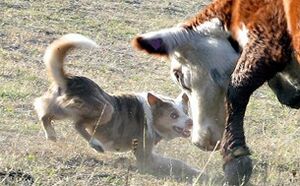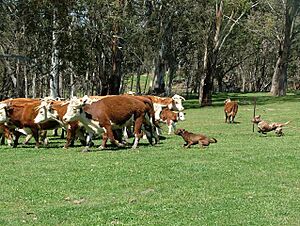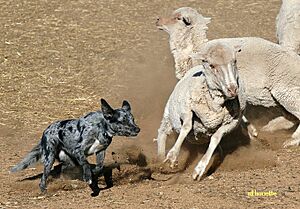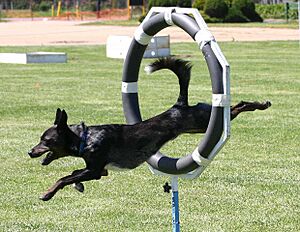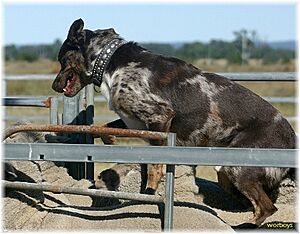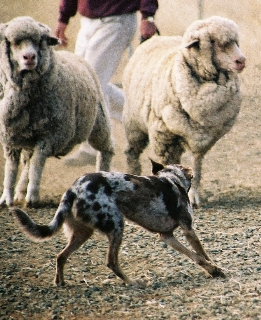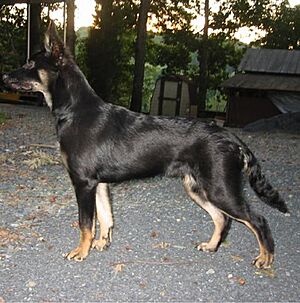Koolie facts for kids
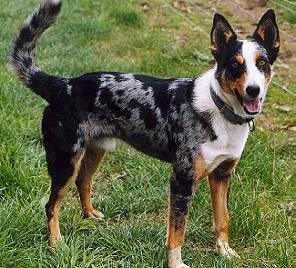
A short-coat blue-merle Koolie
|
|
| Other names | Australian Koolie - German Koolie - Coulie - German Collie |
|---|---|
| Origin | Australia |
| Breed status | Not recognized as a standardized breed by any major kennel club. |
| Notes | Australian Koolies have been recognized on the Australian Sporting Registrar, the American Herding Breed Association's Registrar, the New Zealands Obedience Registrar and the Finland Herding Association. Koolies registered with the Koolie Club of Australia are accepted to the Canine Control Sporting registers in Victoria, New South Wales and Queensland. |
| Domestic dog (Canis lupus familiaris) | |
The Koolie (also known as the Australian Koolie) is a special dog breed from Australia. These dogs are amazing at herding animals like sheep and cattle. They have been helping farmers in Australia since the early 1800s. They were first bred from working dogs brought over from Britain. Sometimes, people mistakenly called them "German Coolies," but they are truly Australian dogs with British roots.
Koolies are known for being quiet and focused working dogs. They are great at moving sheep and can even help with delicate tasks like managing lambs. They are also good at separating specific sheep from a larger group.
Contents
What Does a Koolie Look Like?
Appearance and Size
Koolies look different depending on where they come from in Australia. For example, in northern Queensland, they are tall and lean. This helps them herd large cattle over long distances. In other areas, like the Hunter Valley, they are shorter and stronger. This helps them find cattle in thick bushes.
Koolies are bred to fit the needs of farmers. They are all very flexible and eager to work. They usually stand between 40 to 60 centimeters (about 16 to 24 inches) tall. They come in many different coat types and colors. Most Koolies have a special "merle" coat pattern, which means they have splashes of different colors.
Coat Types
Koolies can have different types of coats:
- Short/smooth: This is the most common type. It's easy to care for and doesn't pick up grass seeds.
- Short: Similar to a working Kelpie's coat.
- Medium: A bit longer than the short coat.
- Long: This is rare, but some Koolies have coats like a show Border Collie.
Most owners prefer the short or smooth coats. They are easy to keep clean and shiny.
Colors and Markings
Koolies come in many colors:
- Solid: All one color, like black or red/chocolate.
- Bi-color: Two colors, such as black and white or red and white.
- Tri-color: Three colors, like solid red or black with white markings and brown spots.
- Merle: This is a common pattern. It looks like splashes of darker colors (black, grey, red, or chocolate) on a lighter background.
Koolies can have different eye colors too. Black Koolies often have black or blue eyes. Red or chocolate Koolies usually have brown or yellow eyes. Sometimes, a Koolie can even have one blue eye and one brown eye!
Koolie Temperament and Personality
Koolies are chosen by farmers for their excellent working skills. They are very smart dogs. They need good guidance and training. A calm and supportive approach works best. When trained well, Koolies can adapt to many different situations.
These dogs are known for being patient, dedicated, and very willing to please. They are not usually aggressive. However, they can show dominance if needed. They love to work and are very tough when the job is hard. Koolies make loyal companions and can be great in dog sports too.
Koolie Health and Care
Koolies typically live for about 15 years. This is a normal lifespan for a dog of their size. Like all dog breeds, Koolies can have some health issues. However, their varied gene pool helps keep them generally healthy.
It's important for breeders to test for certain conditions. For example, hip and elbow problems can be checked. The "merle" gene, which gives them their unique coat, can sometimes cause blindness or deafness in puppies if not bred carefully. Breeders often test for this gene to ensure healthy puppies.
How Koolies Herd Animals
Koolies are very popular working dogs in Australia. People in other countries like America, Canada, and Europe are also becoming interested in them. Koolies can do many different herding tasks:
- Head: They move to the front of the animals to turn them back towards the owner.
- Heel or Drive: They push the animals from behind.
- Cast: They move out and around the animals to gather them.
- Block: They hold the animals in one place or stop them from moving forward.
- Back: They can even jump onto the backs of sheep to move them if needed!
Koolies are known for being "upright workers." This means they don't always crouch low like some other herding dogs. They can easily switch between holding a group of animals and gathering ones that have strayed. They are comfortable working in small spaces like yards or trucks, as well as out in large fields. They can herd almost any animal, from ducks to bulls! They might even try to herd family members if there are no other animals around.
The History of the Koolie Dog
The Koolie's ancestors were smooth-coated Collie dogs. These dogs were brought from Britain to Australia in the 1800s. Some people believe Koolies are related to the dogs owned by Thomas S. Hall, who helped create the Australian Cattle Dog breed.
Over time, some Koolie bloodlines were mixed with other working breeds like the Kelpie and Border Collie. This happened because farmers wanted the best working dogs available.
In 2000, the Koolie Club of Australia was started. Its goal is to protect and promote the Koolie breed. The club focuses on the Koolie's working abilities. They don't aim for the breed to be judged in dog shows based on looks alone.
Since 2004, Koolies have been recognized by the Australian Sporting Registrar. This means they can compete in dog sports like herding, obedience, and agility events. In 2006, the American Herding Breed Association also recognized the Australian Koolie.
Koolies Around the World
Koolies have been exported to many countries. In 2002, the first registered Koolies were sent to America. Later, Koolies were also sent to New Zealand, Finland, and Switzerland. This shows how popular and valued these amazing working dogs are becoming worldwide!


